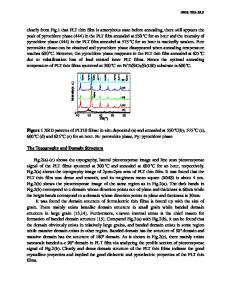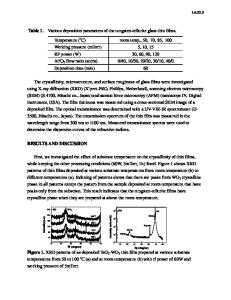Study of Photoluminescence Properties of Cu x O Thin Films Prepared by Reactive Radio Frequency Magnetron Sputtering
- PDF / 217,728,779 Bytes
- 7 Pages / 612 x 792 pts (letter) Page_size
- 82 Downloads / 343 Views
Study of Photoluminescence Properties of CuxO Thin Films Prepared by Reactive Radio Frequency Magnetron Sputtering Jiantuo Gan, Augustinas Galeckas, Vishnukanthan Venkatachalapathy, Heine N. Riise, Bengt G. Svensson and Edouard V. Monakhov University of Oslo, Department of Physics /Center for Materials Science and Nanotechnology, P.O. Box 1048 Blindern, N-0316 Oslo, Norway ABSTRACT CuxO thin films have been deposited on a quartz substrate by reactive radio frequency (rf) magnetron sputtering at different target powers Pt (140-190 W) while keeping other growth process parameters fixed. Room-temperature photoluminescence (PL) measurements indicate considerable improvement of crystallinity for the films deposited at Pt>170 W, with most pronounced excitonic features being observed in the film grown using Pt=190 W. These results corroborate well with the surface morphology of the films, which was found more flat, smooth and homogeneous for Pt >170 W films in comparison with those deposited at lower powers. INTRODUCTION Cu2O, cuprous oxide, is an intrinsically p-type semiconductor with a relatively broad bandgap of Eg = 2.1 eV, making this material very promising in solar cell applications, where Cu2O as a sunlight absorber offers theoretical efficiency up to 18% [1]. In general, copper oxides are chemically stable, non-toxic and earth abundant and are therefore suitable as candidate material for preparing next generation solar cells with high efficiency at reduced costs. However, currently reported efficiency values remain at 2~5% for this type of single junction solar cells [2, 3]. For better understanding of the CuxO material properties and improvement in photovoltaic device performance, both thin film properties with their correlation to bulk defects and heterojunction interface defects should be investigated. Using reactive magnetron sputtering, copper oxides with different phases can be deposited simultaneously, e.g., Cu2O, CuO and Cu4O3, depending on Cu-rich/O-rich growth conditions, substrate temperature and oxygen partial pressure. In our earlier study [4], the target power Pt was shown to have a strong influence on the composition of copper oxides and their electrical, optical and structural properties. The electrical properties of Cu2O are commonly considered to be determined by lattice defects [5], i.e., O-vacancies or Cu-vacancy with the intrinsic p-type conductivity originating from the latter [6] while n-type activity arises from compensating oxygen related vacancies (or copper interstitials) [7]. The conductivity type of the resulting film is therefore usually believed to be determined by a competition between these intrinsic defects. To further understand the correlation between the above stated electrical properties and films with different stoichiometry, defects with energy states in the forbidden bandgap of CuxO should be investigated. In the present work, room temperature (RT) PL measurements were carried out to assess crystallinity and to analyze defects in CuxO films deposited under a series of targ










